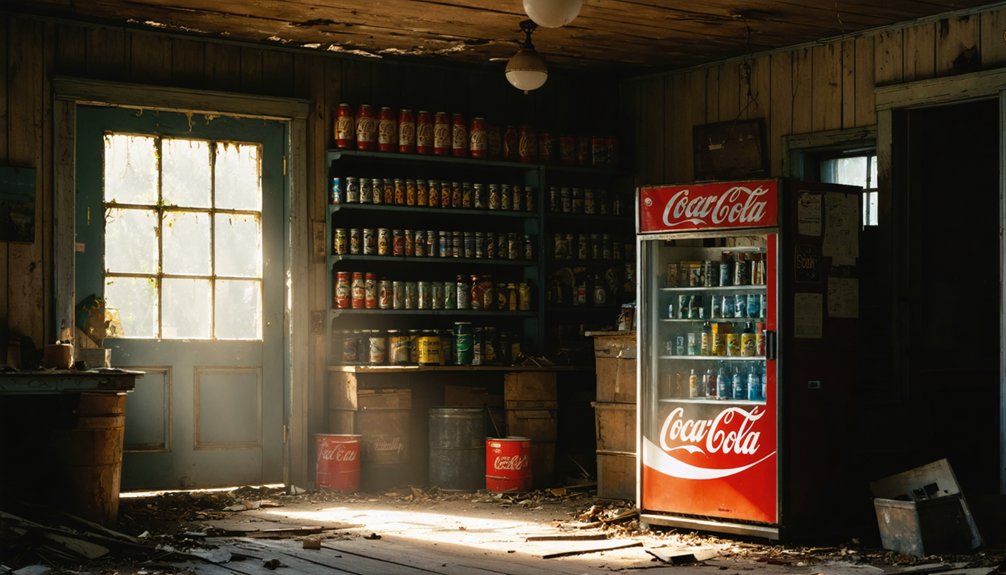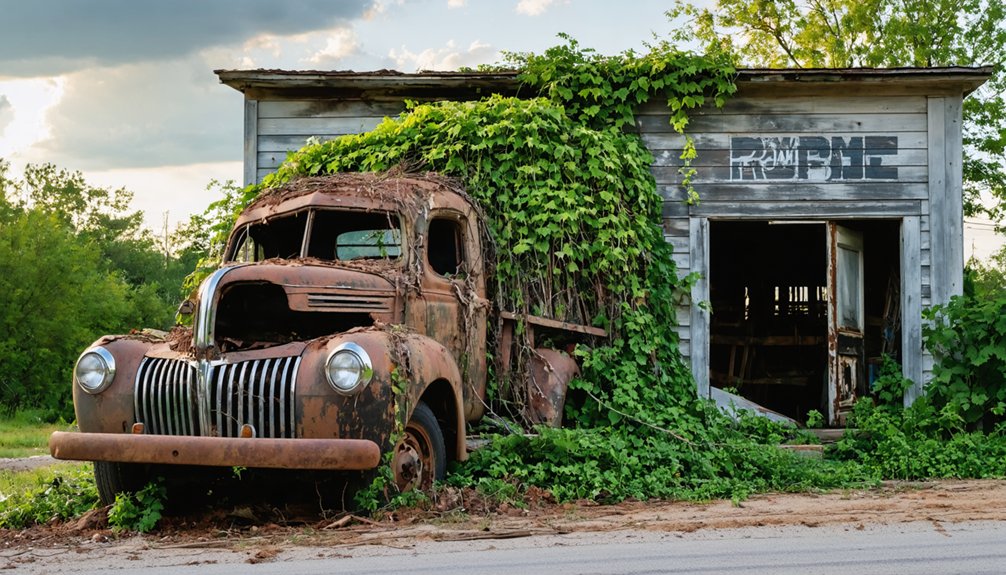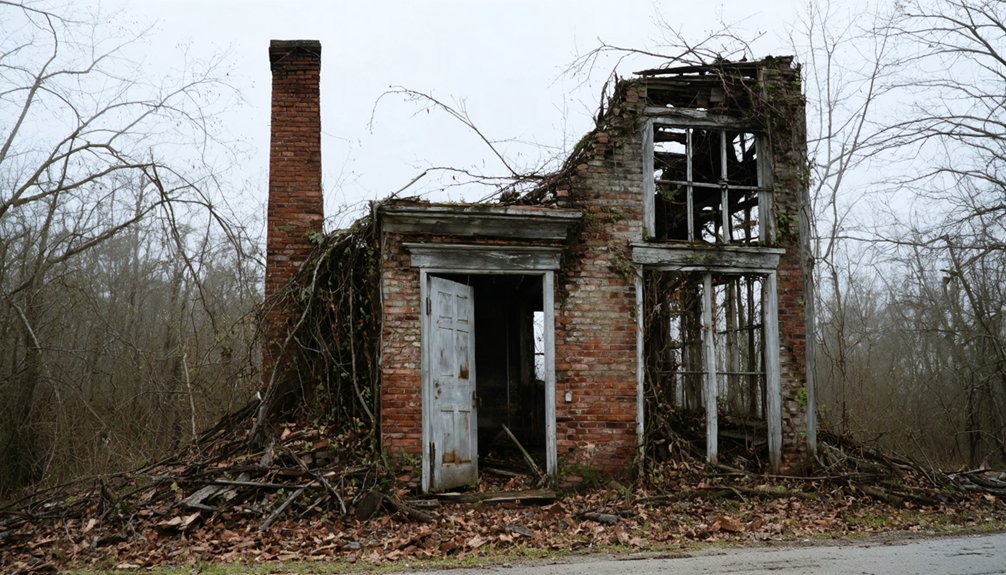You’ll find Manasco’s ghost town remains 14 miles from Jasper along Highway 124 in Walker County, Alabama. Founded in 1879 by David C. Manasco, a Georgia native and Union supporter, the settlement faced intense Civil War persecution before experiencing a brief period of growth. Despite the founding family’s political influence, including congressman Carter Manasco’s legacy, the town succumbed to economic isolation by 1900. Today, hand-dug wells and a historic cemetery hold clues to this lost community’s fascinating story.
Key Takeaways
- Manasco was established in 1879 by David C. Manasco and became a ghost town by 1900 due to economic isolation.
- Located 14 miles from Jasper along Highway 124, the town faced decline despite its strategic placement in Walker County.
- The town’s Union sympathies during the Civil War created lasting tensions that contributed to its eventual abandonment.
- Only a historic cemetery and remnants of hand-dug wells remain as physical evidence of the former settlement.
- The influential Manasco family, including Congressman Carter Manasco, left a lasting political legacy despite the town’s disappearance.
The Founding Vision of David C. Manasco
When David C. Manasco established his namesake town in 1879, he’d already experienced decades of life in the American South. Born in Franklin County, Georgia, in 1802, he brought his founder’s vision to Walker County, Alabama, selecting a strategic location just 14 miles from Jasper along what would become Highway 124.
As a farmer and member of a prominent family that included his brother General John Manasco, a founding legislator of Alabama, David understood the importance of establishing roots in this promising region. His Union sympathies during the Civil War had caused him significant hardship and persecution from Confederate supporters. His choice for town development showcased the area’s potential, positioning Manasco at a crossroads that would later connect to major thoroughfares like Interstate 22.
Though the town eventually became one of America’s oldest ghost towns, his vision initially created a foothold for generations of settlers in northwestern Alabama. The town maintained a vital communication link through its Post Office until 1889, serving the growing community during its brief existence.
Union Loyalty in Confederate Territory
You’ll find that Union supporters in Manasco faced intense persecution during the Civil War, as Confederate sympathizers threatened their lives and property for maintaining loyalty to the United States.
The wartime threats prompted many Manasco residents to file claims with the Southern Claims Commission after the war, seeking compensation for property seized or destroyed by Confederate forces. David C. Manasco himself filed a claim testifying to his unwavering Union support despite facing threats from Confederate neighbors.
Local families endured tragic losses, as demonstrated when Home Guard forces executed Joel Jackson Curtis for refusing to join the Confederate Army. These claims, along with the lingering bitterness between Union and Confederate supporters, created deep social rifts that persisted in the community for generations after the conflict ended.
Threats Against Union Supporters
During the Civil War, Union loyalists in Manasco, Alabama faced severe persecution from Confederate forces and sympathizers.
You’ll find that David C. Manasco, a staunch Union supporter, endured constant threats against his life and property from Confederate officers. He spent 41 days in detention during 1864, accused of participating in Union league activities. He demonstrated his commitment by helping forty-one Union men escape to federal lines.
Confederate “layouts” – informal militia groups – worked systematically to suppress Union loyalty through intimidation and social pressure. Despite his lifelong political career, General Jeremiah Manasco chose to remain loyal to Alabama after secession, though he initially opposed it.
If you were a Union supporter in this region, you’d face harassment, property seizures, and food confiscations that made daily survival difficult.
Even family ties couldn’t protect you, as the Manascos discovered when their own relatives split between Union and Confederate causes, creating deep rifts that reflected the broader divisions in northern Alabama’s Winston County.
Wartime Claims Commission Filings
After enduring years of persecution, David C. Manasco filed extensive SCC claims documenting his unwavering Union loyalty in Confederate-controlled Walker County, Alabama. His 40-page testimony revealed the steep price you’d pay for standing against secession in the Deep South, where Union resilience meant facing constant threats to life and property.
You’ll find in Manasco’s detailed claims evidence of how Southern Unionists navigated treacherous waters, often providing covert aid to Union forces while avoiding Confederate retaliation. Like those who defended Fort Blakely’s earthworks, these Unionists played a crucial role in supporting Federal forces deep behind enemy lines.
Much like the documented events in Chambers County, the area saw significant Civil War activity that shaped local history.
His testimony to the Southern Claims Commission painted a vivid picture of wartime losses – from seized livestock to damaged farmland – all while maintaining his principles despite intense pressure from Confederate neighbors.
His records stand as powerful proof of the hidden resistance that existed throughout Alabama during the Civil War.
Post-War Community Tensions
While many Alabama communities struggled to rebuild after the Civil War, tensions between Union loyalists and Confederate sympathizers remained particularly stark in Walker County.
You’d have found deep community divisions, with some families split between those who’d fought for the Union and those who’d supported the Confederacy. These divisions often traced back to long-standing family traditions, with Union sympathizers frequently having ancestors who’d fought alongside Andrew Jackson.
Despite reconciliation efforts, the wounds ran deep. Confederate supporters often viewed their Union-loyal neighbors with suspicion, while Union families faced ongoing social pressure and occasional threats. Local Unionists found safety by forming resistance networks that provided support and protection. This contentious environment shaped the early years of Townley native Pete Manasco, who would later represent the region in Congress.
These tensions shaped daily life in the area, affecting everything from business dealings to social gatherings, and would continue to influence community relationships for generations.
Life in a Post-Civil War Settlement
Life in post-Civil War Manasco presented stark challenges as the settlement grappled with Alabama’s transformed social and economic landscape.
The rugged settlement of Manasco faced daunting obstacles as it navigated the seismic shifts of postwar Alabama society.
You’d find a community showing remarkable resilience as they worked to rebuild their lives amid the economic hardships that followed the end of slavery. The settlement’s social cohesion was tested as residents navigated the complex political landscape of Reconstruction.
- Railroad development brought new opportunities for trade and commerce
- Former Confederate and Unionist neighbors had to find ways to coexist
- Agricultural practices shifted as new labor systems replaced slavery
- Families relied heavily on kinship networks for support and survival
- Education and literacy initiatives emerged as priorities for community growth
The transformation wasn’t easy, but Manasco’s residents adapted to these changes while maintaining strong family ties and working to establish economic stability in their corner of Alabama.
The Rise and Fall of a Rural Community
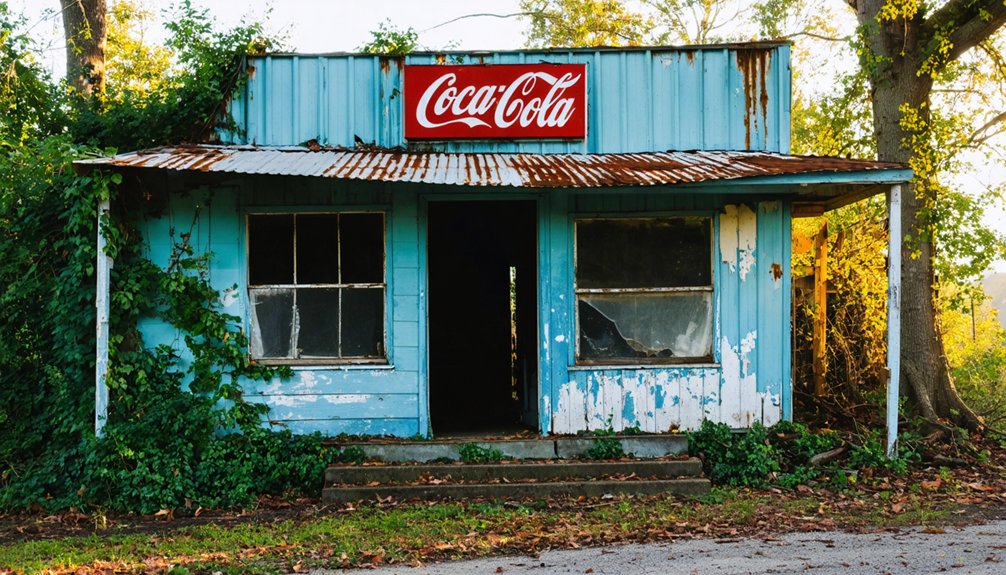
You’ll find Manasco’s story typical of post-Civil War settlements in Walker County, where rural families established tight-knit agricultural communities amid Alabama’s challenging reconstruction period.
The town’s early growth centered on the Manasco family’s migration from Georgia, with farming as the primary economic driver and limited access to major transportation routes shaping its development.
While the exact timeline remains unclear, Manasco’s gradual decline mirrors many rural Alabama communities that faded as residents sought opportunities elsewhere, leaving only the cemetery with over 100 graves as evidence to its once-vibrant population.
Post-Civil War Settlement
As Alabama emerged from the devastation of the Civil War, Manasco’s settlement reflected the broader challenges of Reconstruction-era development in the state.
Despite the settlement challenges, you’ll find that early settlers demonstrated remarkable community resilience, establishing themselves amid the shifting economic and social landscape of post-war Alabama.
The community’s growth was shaped by several key factors:
- Available land following the Creek Indian wars created opportunities for new settlements
- Railroad expansion improved access to markets and trade
- Agricultural development, particularly cotton farming, provided economic foundations
- Diverse settlers, including freed slaves and white farmers, contributed to the community
- Local crafts and small-scale manufacturing supported the settlement’s economy
The establishment of essential infrastructure and social institutions, particularly churches and schools, helped transform Manasco from a frontier settlement into an organized community.
Rural Population Dynamics
Through its rise and eventual decline, Manasco’s story exemplifies the complex population dynamics that shaped rural Alabama communities in the late 19th century.
You’ll find that this small settlement, founded by David C. Manasco in 1879, struggled with the same challenges that plagued many rural towns of its era.
While the exact population numbers aren’t known, Manasco’s community remained small and isolated, relying primarily on subsistence farming and local trade.
The town’s economic sustainability faced mounting pressure as improved transportation networks drew residents toward urban centers.
By 1900, urban migration had taken its toll, and the settlement was abandoned.
The pattern you see in Manasco’s decline mirrors a broader trend that continues today, as Alabama’s rural areas still grapple with outmigration, aging populations, and shrinking tax bases.
Community Abandonment Factors
Despite its initial promise as an agricultural settlement, Manasco’s decline stemmed from a complex web of interconnected factors that sealed its fate.
You’ll find that shifting agricultural practices and lack of economic diversification severely weakened the community’s resilience over time. Without rail access or major highways, the town couldn’t effectively connect to larger markets, while nearby Jasper drew away resources and population.
- Limited infrastructure development stunted growth potential
- Younger generations migrated to cities for better opportunities
- Absence of new settlers to maintain population levels
- Closure of essential community institutions
- No significant external investment to revitalize the area
The town’s isolation and dependence on traditional farming left it vulnerable to broader economic changes, while the steady exodus of residents gradually eroded the social fabric that had once held the community together.
Traces Left Behind: Wells and Burial Grounds
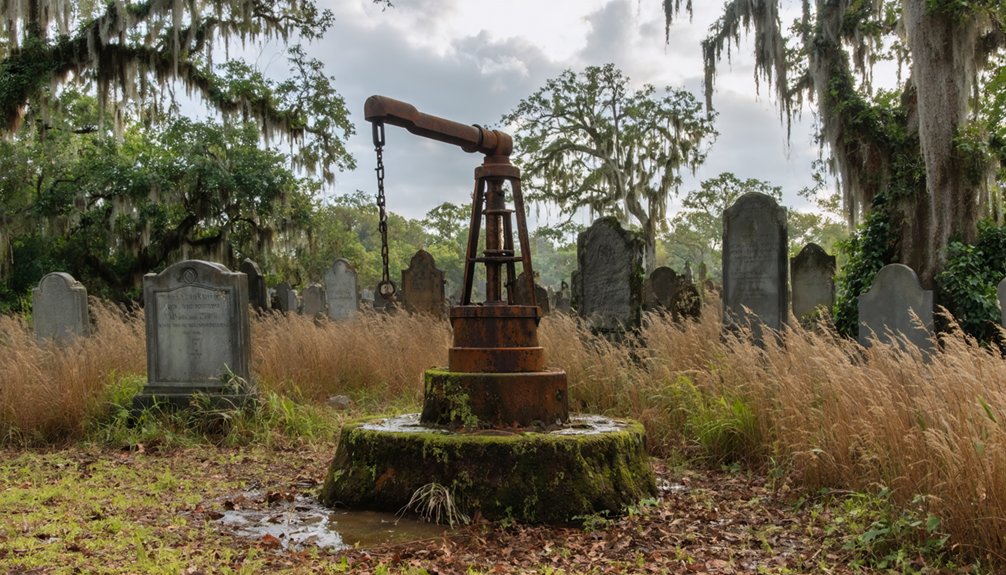
Physical traces of Manasco’s past now primarily exist in its historic cemetery, while evidence of the town’s original wells remains largely hidden from view.
You’ll find the most compelling well remnants beneath layers of vegetation, where hand-dug water sources once served the town’s families and livestock. While these wells have disappeared from sight, their likely locations near former homesteads and community gathering spots could be revealed through careful archaeological work.
The cemetery significance becomes clear as you explore the Manasco burial grounds, where headstones dating to the 1800s tell the story of the founding family and early settlers.
These preserved grave markers provide valuable insights into family structures, mortality patterns, and social connections that shaped this rural Alabama community before its decline.
Post Office Operations and Daily Life
While the cemetery holds stories of Manasco’s residents in death, the town’s post office once served as a significant hub of life and connection. From 1879 to 1900, you’d find residents gathering at this important establishment, sharing news and collecting mail that connected them to the outside world.
Community interaction centered around this public space, reflecting the town’s structured social fabric.
The post office served as more than a mail hub – it was the heartbeat of Manasco’s social structure and daily rhythms.
Key aspects of Manasco’s post office operations:
- Served as the primary communication link with other towns
- Facilitated commerce and trade through mail services
- Provided a natural meeting point for community members
- Operated during the town’s most active period
- Represented an indispensable government service in an era before modern communication
The post office’s presence suggests Manasco was once a thriving community with regular correspondence and commercial activity.
Legacy of the Manasco Family
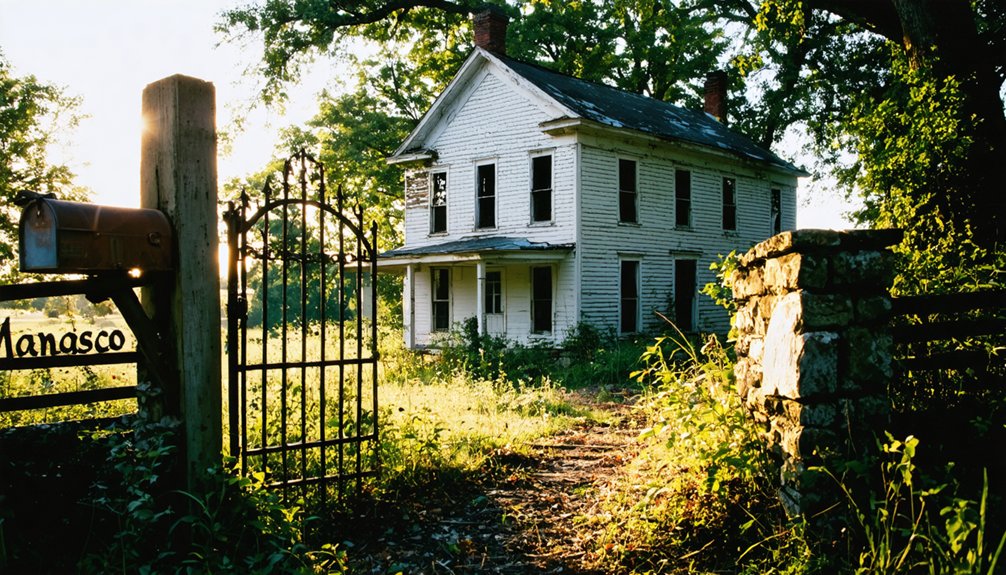
As one of Alabama’s most influential pioneer families, the Manascos left an indelible mark on Walker County’s development through their founding of Manasco in 1879. The Manasco Heritage began with David C. Manasco, born in Georgia in 1802, who established the town alongside his brother, General John Manasco. Their family’s strong ties to Andrew Jackson reflected their political influence during the Civil War era.
The Family Contributions extended well beyond the town’s boundaries, shaping the development of Walker, Winston, and Fayette Counties.
You’ll find their legacy preserved in the Manasco Cemetery, where generations of family members rest, including David C. Manasco, who lived until 1894.
Today, their descendants, like Steven Douglas Manasco, continue to uphold the family’s historical significance in northwestern Alabama.
Mapping the Lost Town’s Location
Today, you’ll find the lost town of Manasco nestled approximately 14 miles from Jasper along Highway 124 in Walker County, Alabama.
Modern mapping techniques can help you locate this historical site along Wolf Creek Road (173) and Pleasant Hill Road, though the 160 acres that once belonged to David C. Manasco have largely blended into the surrounding countryside.
For those interested in historical cartography and exploration, here are the key markers to guide your journey:
- Access the site via Wolf Creek Road, which intersects with Pleasant Hill Road
- Look for the well-documented Manasco Cemetery, featured in over 100 photographs
- Navigate through what’s now a mix of residential areas and large farms
- Use interactive tools like BatchGeo to pinpoint the ghost town’s location
- Follow the rural road approximately 3.1 miles to reach the general vicinity
Economic Challenges and Abandonment
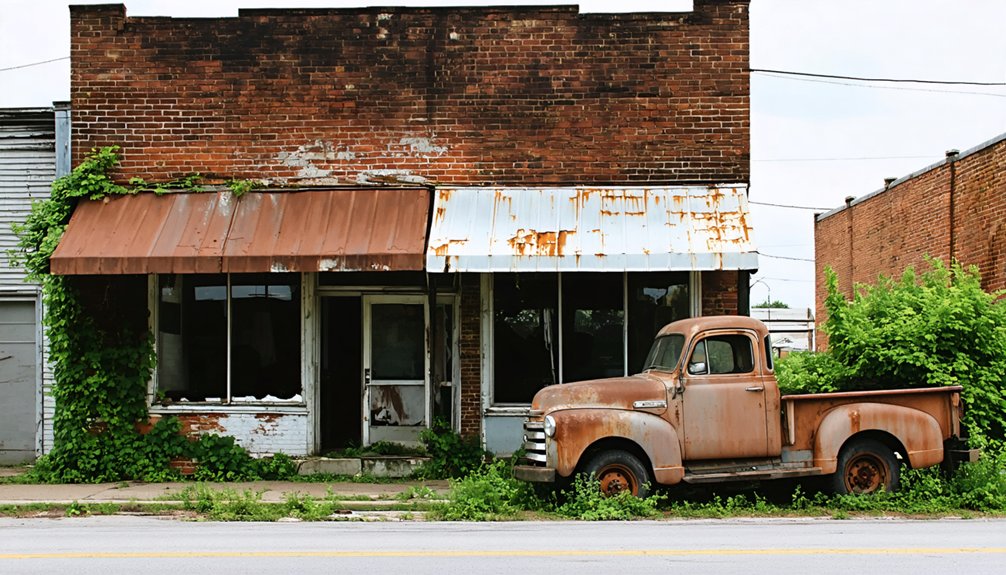
Despite its promising beginnings as a 160-acre settlement, Manasco faced severe economic challenges that ultimately led to its abandonment by 1900.
You’ll find evidence of economic isolation in the town’s limited infrastructure, with only hand-dug wells and a cemetery remaining today. The settlement’s agricultural viability proved insufficient to sustain growth, as nearby towns like Jasper offered better opportunities and resources.
Unlike successful Alabama ghost towns that thrived on mining or railways, Manasco couldn’t compete without major transportation links or industrial development.
You can trace the town’s decline through the closure of its post office and the exodus of residents seeking employment elsewhere. The proximity of larger, commercially active towns in Walker County sealed Manasco’s fate, drawing away both commerce and population.
Historical Significance in Walker County
Manasco’s historical significance in Walker County extends far beyond its brief existence as a settlement, thanks to the influential Manasco family‘s deep political connections and multi-generational presence in the region.
You’ll find the Manasco heritage woven throughout Walker County’s political landscape, from Carter Manasco’s congressional service to the family’s ties with prominent figures like Tom Bevill.
- Manasco Cemetery serves as a crucial historical landmark preserving early settler history
- The town’s founder, David C. Manasco, established strong Andrew Jackson-era political connections
- Family members held positions in both the Alabama legislature and U.S. Congress
- Geographic location near Jasper and Townley made it a hub for regional politics
- The family’s civic leadership shaped Walker County’s development throughout the 20th century
Frequently Asked Questions
Were There Any Schools or Churches Established in Manasco?
You won’t find documented school history or church significance in Manasco, as historical records don’t show any established educational or religious buildings in this small Walker County community.
What Natural Disasters or Epidemics Affected the Town?
In this land where storms shook the earth like giants, you’d face nature’s fury through devastating floods and tornadoes. Local records hint at yellow fever and cholera outbreaks that likely weakened the town’s population.
How Did Residents Get Their Water Supply Besides Hand-Dug Wells?
You’ll find residents relied on rainwater harvesting using barrels and cisterns, while some likely accessed nearby rivers or streams, though specific documentation of their water collection methods remains limited.
What Crops or Livestock Were Primarily Raised in Manasco?
You’d have found cotton farming as the primary agricultural activity, alongside cattle and hog raising. Families typically maintained small livestock breeding operations, growing corn and vegetables for personal sustenance.
Did Native Americans Interact With the Manasco Settlement?
By 1879’s founding, 40+ years after Native American removal, you won’t find evidence of direct cultural exchange. The town emerged decades after tribes were forcibly displaced from Alabama’s lands.
References
- https://familyhistoryfoundation.com/2019/01/11/manasco-alabama-one-of-americas-oldest-ghost-towns/
- https://deepsouthurbex.com/2020/01/02/6-south-alabama-ghost-towns/
- https://familyhistoryfoundation.com/2018/12/24/andrew-jackson-manasco-families-of-alabama/
- https://en.wikipedia.org/wiki/List_of_ghost_towns_in_Alabama
- https://familyhistoryfoundation.com/2015/05/06/rebel-amongst-rebels-david-c-manasco/
- https://www.findagrave.com/memorial/126207388/david-c_-manasco
- https://www.ancestry.com/genealogy/records/results?firstName=david&lastName=manasco
- https://www.myheritage.com/names/david_manasco
- https://digital.archives.alabama.gov/digital/api/collection/hgpub/id/53445/download
- http://www.freestateofwinston.org/jasperraid.htm
